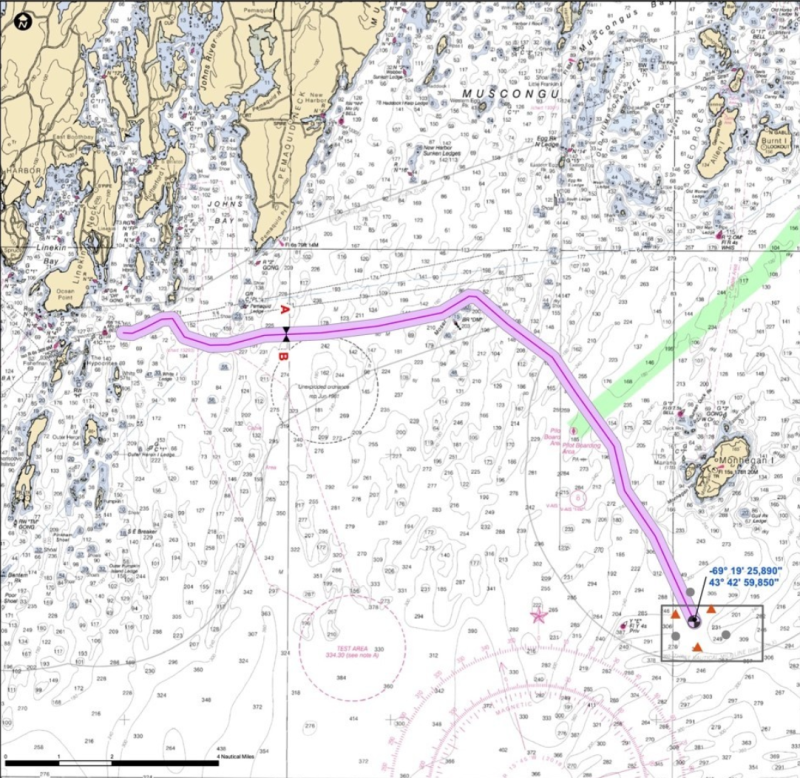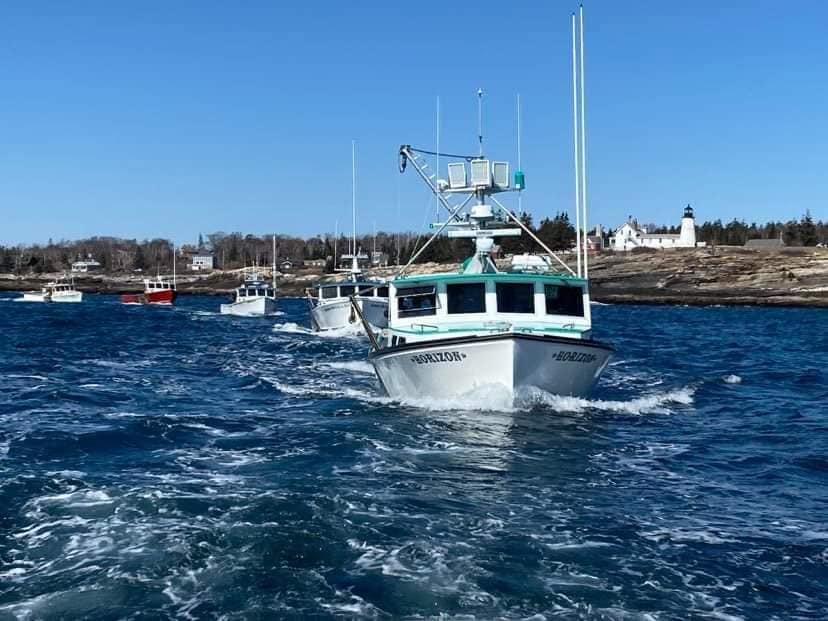With accusations flying between midcoast Maine lobstermen and offshore wind power advocates, state officials worked to reduce tensions as survey vessels chart a future cable route for a planned wind turbine site south of Monhegan Island.
The Maine Aqua Ventus project would be a 12-megawatt floating turbine to test the feasibility of using such anchored generators to build commercial-scale wind power arrays in the deepwater Gulf of Maine. The survey now is over a 23-mile route where an export cable would carry electricity to landfall and tie into the mainland power grid at South Boothbay.
In a bulletin to fishermen Wednesday morning, state Department of Marine Resources Commissioner Patrick Keliher urged continued restraint in protests, after a peaceful demonstration Sunday by more than 80 vessels that cruised the cable route flying banners of protest.
“The purpose of this seabed survey is to map the seafloor in order to determine if the cable bringing power to shore can be buried. The purpose of burying the cable is to allow both mobile and fixed gear to fish around the cable without a problem,” Keliher wrote. “The developer has committed to working with the Department to ensure that fishing will be allowed around and over the cable route. I hope that we can find a way forward to complete this survey and achieve that goal.”

Organized by captains on short notice, the March 21 demonstration involved more than 80 boats trailing the route of a proposed export cable from the floating turbine site south of Monhegan Island to South Boothbay.
“It was very grassroots. It was a few guys who said, ‘We have to do something,’” said Dustin Delano, a Friendship lobsterman and one of the organizers.
“We’re trying to keep Maine waters free from this industrialization,” said Delano. “This would fill the ocean with anchors, cables and chains… Maine is unique in the nation. Our entire heritage is fishing and tourism.”
Beyond the Aqua Ventus project, fishermen are alarmed by state officials planning for a large array of up to a dozen turbines in a 16-square mile area farther offshore.
“Nobody knows what’s going to happen, and fishermen are being told, ‘We need this project to see how it will affect us,’” said Delano. So far fishermen have heard conflicting information about the Aqua Ventus installation — including whether they will be allowed to set gear near the turbine or cables, he said.
“We need that information to be 100 percent accurate,” Delano added.
With the covid-19 pandemic precluding in-person meetings between fishermen and wind developers,“for many of us, the outreach has failed miserably,” he said. “A lot of guys don’t even have a computer or tablet.”
Aqua Ventus planners recognize the limits of online meetings and have worked to get beyond those, said Genevieve McDonald, a Stonington lobster captain who serves in the state House of Representatives and works as the fisheries liaison to Aqua Ventus.
“That’s true, but that’s why we sent out direct mail” to marine fisheries license holders, said McDonald. “The pandemic has certainly made it difficult.”
According to a list provided by McDonald, the effort include three online Zoom meetings during January, a Notice to Mariners sent Feb. 11, another Notice March 2, and five schedule updates from Aqua Ventus distributed by the state Marine Patrol.
Because survey vessels are limited in maneuverability, the company is asking fishermen to maintain a 1-nautical-mile buffer from them.
“It’s beneficial to everyone to get the survey done now” before vessel traffic and gear deployments increase with spring weather progressing, said McDonald. It’s critical and mutually beneficial for the fishermen and wind planners to keep talking, she added.
Keliher’s e-mail missive came after the Sunday demonstration was followed by reports that several lobster boats approached the survey boat Go Liberty, resulting in the survey crew stopping work to maintain a buffer.
The Portland Press Herald quoted an Aqua Ventus spokesman saying the survey crew had counted an apparent doubling of lobster gear deployed along the survey route. Keliher disputed that — but stressed gear still must be moved to enable the survey.
“Over the past 24 hours the press coverage has angered many of you — the amount of gear reported by the survey vessel was much higher than what the Marine Patrol reported to me,” a total of 254 buoys that officers counted, Keliher wrote. “Now that we have an understanding of the amount of gear, it is clear they will not be able to complete the survey unless gear is moved.”
Keliher said he and officers are in discussions with the survey crew about their operations.
“They are making concessions to avoid ‘jogging’ while outside the route, as well as limiting the amount of cable deployed while making turns outside the route where gear is present,” Keliher wrote.
“We are going to work with them to communicate to you where they are working on a given day. They are willing to assist, and now I need you to also please help. I am asking for your cooperation to move the remaining gear that is inside the route to outside the survey area for the next two weeks.”
The Department of Marine Resources has legal authority to move gear along its trawl survey route, and Keliher said the agency will use that authority if it cannot get lobstermen to move theirs from the survey route voluntarily.
“I will be asking Marine Patrol to move it out of the route (we will not be taking gear to shore). I want to avoid them spending this time on this activity, but I have been directed to do so if the survey vessel can’t get this work done,” he wrote. “So please, work with us.
“Again, I do not underestimate the depth of your concerns around the future of offshore wind. Please let me know if I can come to your harbor and talk directly with you about these concerns. I will continue to work with you in good faith to represent those issues, and advocate for the research that is necessary to understand the ramifications of these projects.”
Gear in the water has been on an uptick up and down the coast, as good weather came early in Maine waters.
“I believe the survey company is doing the best they can,” said Delano. But with the onset of spring, the potential for gear conflict escalated, he said.
“Lobsters are $10 (per pound) to the boat,” he added. “A lot of guys are itching to get out there.”







